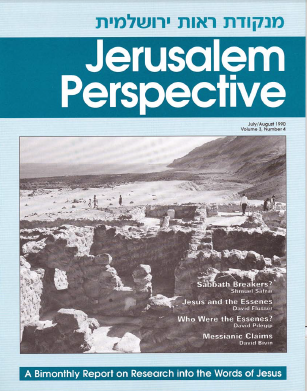Many images flash across the mind when this sect of Jewish mystics is mentioned. Life in the desert, asceticism, harsh discipline, caves, scrolls and idealism seem inextricably associated with the Essenes. It is these images that Professor David Flusser addresses, attempting to carry the reader back through the centuries to explore the life and thought of these fascinating men. His purpose is to paint a broader picture of the Essene sect so often neglected by the generally narrow focus of the scholarly world.
Based on a series of radio lectures, the book retains much of its original conversational tone and structure, but has been expanded to present a more detailed overview. Flusser opens with a general introduction to the Essenes and their origins, then describes their relationship to the Pharisees and Sadducees, the organization of the sect and aspects of its daily life. Only after this groundwork is laid are the various doctrines, beliefs and ideologies explored.
Flusser continually draws from a broad reservoir of ancient texts and recent scholarship, much of it his own, as he surveys the sect’s beliefs of predestination, the “true Israel,” the conflict between light and darkness, spirit and flesh, the Messiah and the Apocalypse.
As the author points out, examining the theologies of this sect often sheds light on the reader’s own views of God and life:
If the reader finds Essene thought limited, perhaps he will discover that his own beliefs also have limitations and unsubstantiated assumptions, and that his own philosophy and expectations, like those of the Essenes, are also “castles in the air.” (p. 8)
Like many sects, the Essenes regarded themselves as the Elect, having a monopoly on God. This brought the group into conflict with other currents in Judaism and fostered an insensitivity to the problems of the rest of the world. Furthermore, the Essenes had their own rules of behavior, as well as a separate halachah that they wished to impose on the whole House of Israel. The Scroll of the War of the Sons of Light against the Sons of Darkness describes this attitude, depicting the final paroxysm in which not only the Land of Israel is reclaimed according to God’s will, but the entire world is conquered. These “Sons of Light” would personally usher in the divine kingdom and be the final inheritors of the earth. In this context Flusser laconically mentions that similar attitudes recur in modern history, with the tacit implication that some self-examination might be in order.

In the process of his examination, the author traces many Christian characteristics to Essene origins or influences. While the Essenes held rigidly to a belief in their ultimate vindication, they paradoxically tended towards pacifism. The evil of the day—whether religious or political—was not to be opposed with violence, and they preferred to leave it to God to redress injustice. To do otherwise would be to interfere with the divine plan, to resist the predestined order of things. This same view is apparent in the writings of the apostle Paul (cf. Romans 13:1-6), and Flusser credits the first six chapters of the early church document, Doctrine of the Twelve Apostles (Didache), directly to the Qumranic Community Rule. In this way, he asserts that many beliefs held throughout the world, not just in Christian and Jewish circles, owe much to the ideology of the Essene community.
The Spiritual History of the Dead Sea Sect reads easily and is unencumbered with technical jargon. At the same time, its notes ensure that finer details, cross-references with other research and extensive quotations from the Essene scrolls, are not overlooked. While the book does not focus specifically on the Gospels, it is nonetheless a fascinating popular treatment of the beliefs, literature and men of the Essene community which were a vital part of the fabric of Jesus’ world.

Paid Content
Premium Members and Friends of JP must be logged in to access this content: Login
If you do not have a paid subscription, please consider registering as a Premium Member starting at $10/month (paid monthly) or only $5/month (paid annually): Register
One Time Purchase Rather Than Membership
Rather than purchasing a membership subscription, you may purchase access to this single page for $1.99 USD. To purchase access we strongly encourage users to first register for a free account with JP (Register), which will make the process of accessing your purchase much simpler. Once you have registered you may login and purchase access to this page at this link:































































































